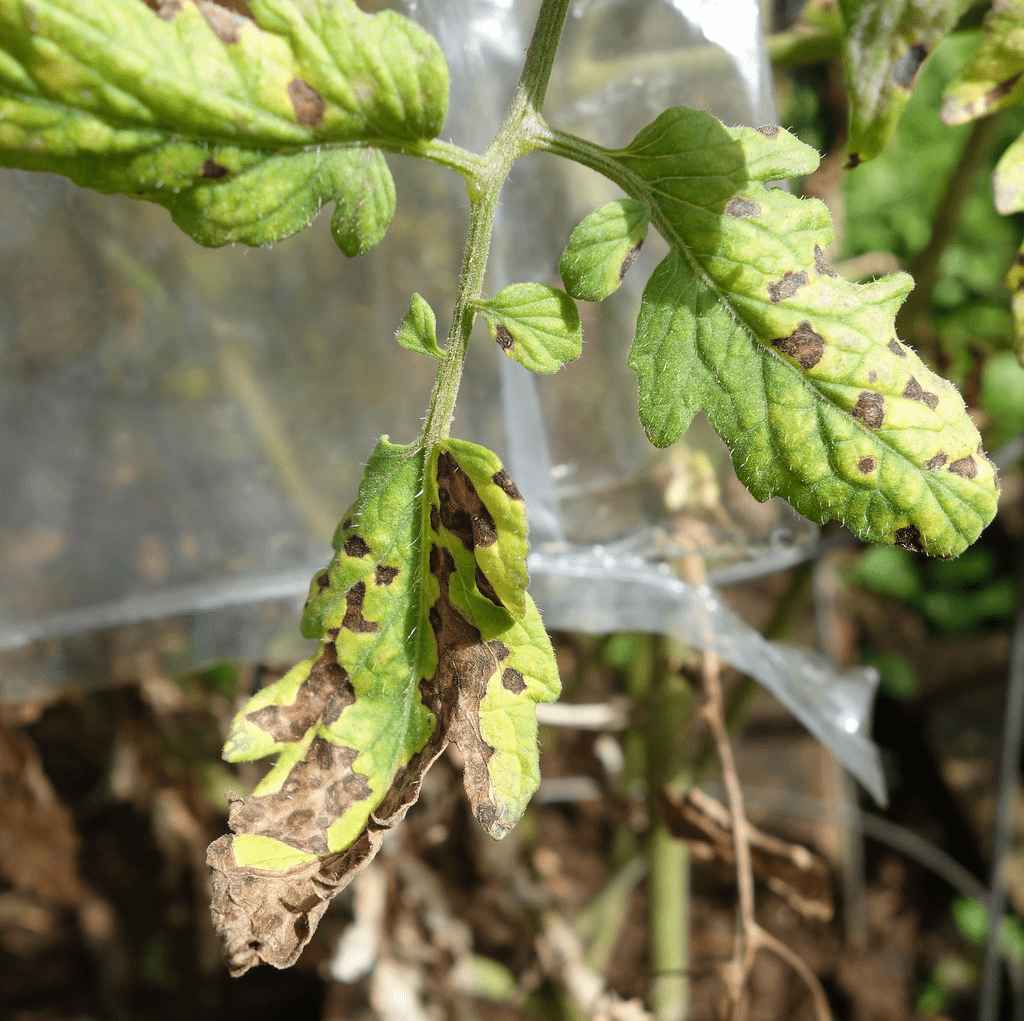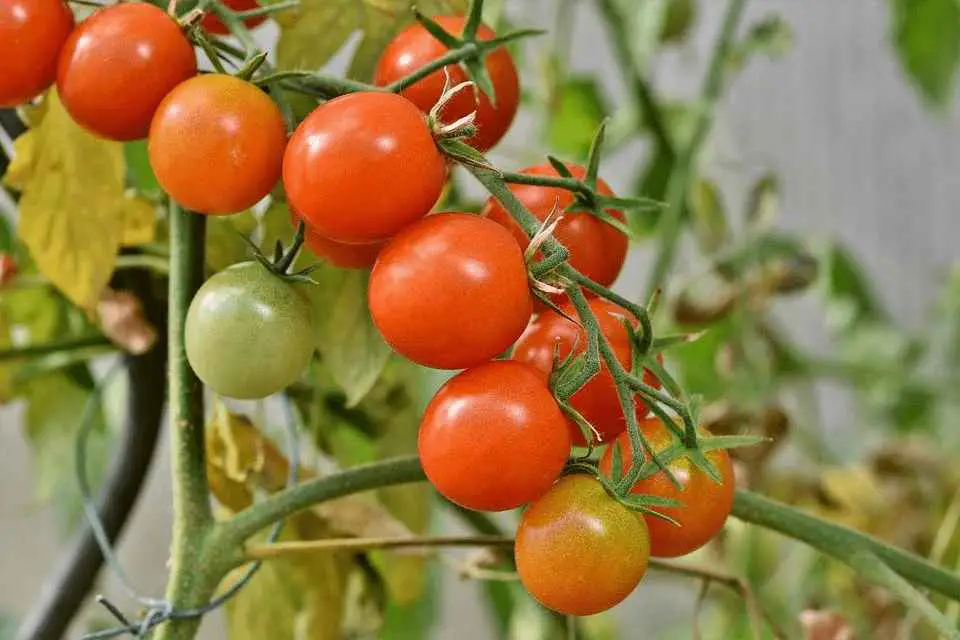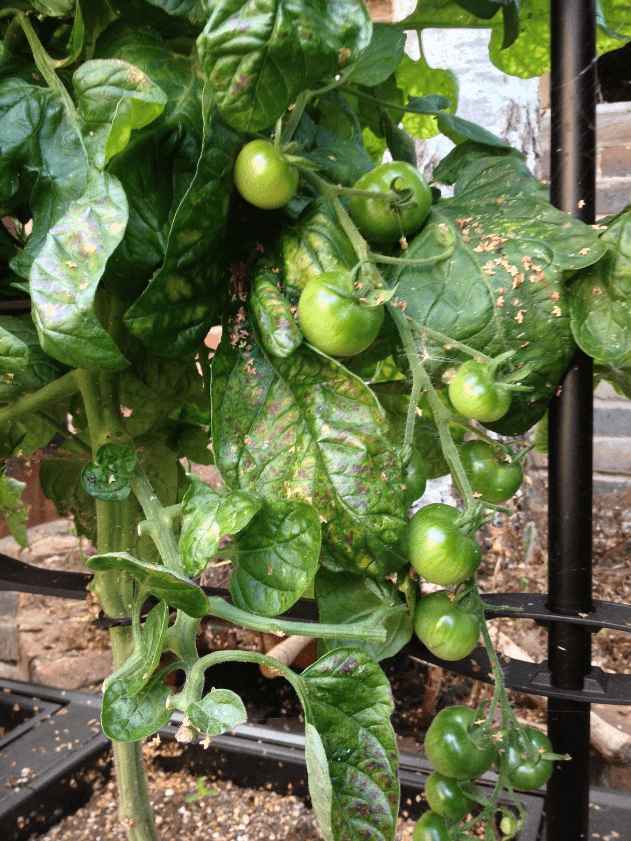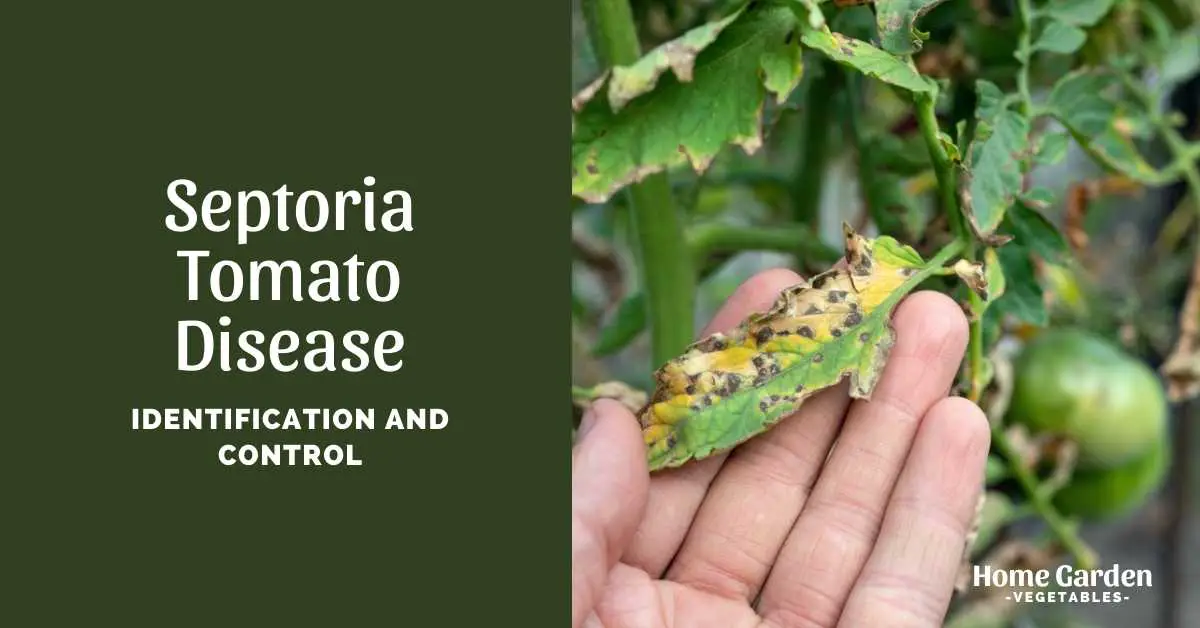Septoria tomato diseases, commonly known as septoria leaf spot or septoria blight, is a common disease that affects tomato crops. Not only does it affect tomato plants, but also other plants from the same family, including eggplant and potatoes. The fungus Septoria lycopersici is responsible for the problem and is known to affect tomato plants in many regions around the world.

How can you tell if its septoria tomato diseases that you’re up against, or is it something else? How serious is it? How do you control it? Keep reading, and you’ll find out everything.
Reader Poll: What online courses would interest you?
How Does Septoria Leaf Spot Affect The Plants?
Septoria tomato diseases won’t necessarily kill your tomato plants, but it can render heavy damage on the crop. Once it appears on a single plant, it will spread to others quickly, defoliating and weakening them.
As the disease takes a toll, the plants are diminished of their ability to produce mature fruit. Ultimately, your harvest suffers severely if septoria leaf spot isn’t controlled in time.
The good news is, if you catch it early, you can control it and salvage your tomato plants.
Subscribe to our newsletter!
How Does Septoria Leaf Spot Spread?

The topsoil is the most common hideout for the Septoria lycopersici fungus. They linger, waiting for the right conditions to get to the host plant. They can survive on the tomato or other nightshade plants debris and weeds from last growing season and overwinter to resume their activity for the new season. They can also come from the stakes and cages you used during the previous growing seasons. Wind and water can also bring them into your garden.
The fungus is often transported to your plant by water splashing off the soil. It can, then, spread from plant to plant through the wind, water, and the use of contaminated gardening tools. Warm and damp conditions provide the ideal environment for the development of the pathogen.
Signs And Symptoms Of Septoria Leaf Spot
Septoria leaf spot hits the older leaves initially, so you’ll find the symptoms on the underside of the lower leaves if the disease is in its early stages. Small, circular spots, 1/16 to ¼ inches in diameter with grey centers and dark brown margins are typical of septoria leaf spot.
As the disease progresses, the spots grow bigger and join together. If you inspect closely, you may also find fruiting bodies in the center, similar to black pimples. There may be several spots on a single leaf, first appearing on the older leaves, and later moving towards the new growth.
If they’re too many lesions on the leaves, they’ll eventually turn yellow, wither and die. The disease can also affect the stems, flowers and calyxes. On the bright side, it will rarely affect the fruit. However, it will weaken the plants, which ultimately affects the yield. Even the tomatoes that do make it to maturity are prone to sunscalding because of the loss of leaves.
Treatment And Control Of Septoria Leaf Spot

Once the symptoms of septoria tomato diseases appear on the plant, there are certain things you can do to control it, but only if caught early.
- Remove Infected Leaves
Prune out all the infected leaves immediately to prevent the spread. Disinfect the pruning tools before working with them on healthy plants. Burn the leaves or seal them in a plastic bag before dumping them. Never compost diseased leaves or plants.
- Organic Fungicides
Organic fungicides are very helpful in containing septoria tomato diseases and other fungal infections. Although they will not cure the infected leaves, their regular application will help prevent the fungal spores from spreading to the healthy leaves. Start spraying the plants right after you notice the symptoms and continue the treatment according to the package instructions.
- Chemical fungicides
Your preliminary choice should always be organic solutions. However, if they don’t work, like in the case of advanced stages of the infection, chemical fungicides may be the last resort. Thankfully, one of the best chemical fungicides for controlling septoria leaf spot, chlorothalonil, is also the least poisonous. It’s typically sold by the names Daconil, and Fungonil.
Prevention Of Septoria Leaf Spot
It’s always better to avoid the infection in the first place. Here are some helpful gardening practices that will keep your plants disease-free:
- Choose septoria resistant tomatoes when purchasing seeds or seedlings. You’ll find more on this later in the post.
- The fungus can survive on the debris of infected plants and overwinter. Dispose off all plant debris properly at the end of each growing season. Burn or destroy the infected plants and do not compost them.
- Mulch around the base of tha plants to prevent fungal spores from being transferred to the stems and leaves through water splashes.
- Keep the leaves dry while watering. Always water at the base so you can avoid drenching the foliage.
- Space the plants adequately while planting the seeds, so there’s ample room for air circulation.
- If you’ve encountered septoria leaf spot in your garden, do not plant tomatoes or any other plant from the nightshade family in the same location for the next season.
Septoria Resistant Tomatoes

Choosing septoria resistant tomatoes is a good option, especially if your plants have encountered the disease during the past growing seasons.
Seeds packets and seedlings sold at nurseries and stores often have resistance codes mentioned with them. If you see the code SLS on a seed packet or seedling label, that particular cultivar is resistant to septoria tomato diseases.
The two most popular septoria resistant tomatoes are Iron Lady and Jasper. Luckily, together with septoria leaf spot, they’ll also resist early and late blight.
Can You Eat Tomatoes With Septoria Leaf Spot?
Septoria leaf spot quickly weakens the plant and affects the yield. It spreads fast and can affect the entire crop if not controlled in time. However, if your tomato crop is already affected by the disease, what should you do with the fruits? Can you eat them without worrying about any consequences on your health?
The simple answer is, yes, you can eat healthy tomatoes from a diseased plant. The organism that causes the Septoria disease in tomato plants is not harmful to human health.
However, if the fruit is heavily affected, there may be other microbes that thrive in the conditions, and you never know which one of them may be harmful. The simple solution is to cut off any visibly damaged portions on the fruit, and eat the remaining healthy part. If the fruit is heavily affected, it’s better to discard it altogether. Eating the affected portions may harm your health since they are ideal breeding ground for several other organisms.
Can Septoria Leaf Spot Kill A Tomato Plant?
Septoria leaf spot spreads quickly and is fast to weaken the plant. Though it’s not typically lethal, if the disease is left untreated and allowed to progress, it may eventually kill the plant. However, if suitable treatment steps are taken in time, it’s possible to save the plant.
Can You Cure Septoria Leaf Spot In Tomatoes?
While there are certain tomato diseases which cannot be treated completely once they attack the plant, septoria leaf spot isn’t one of them. Many fungicides registered for use on tomato plants can treat septoria leaf spot. These include maneb, benomyl, mancozeb, and chlorothalonil. Captan will not work on the disease.
Start fungicide applications according to the instructions on the label as soon as you notice the symptoms. They are generally applied weekly, or on a 10-day schedule. You may apply more frequently if the plants are heavily affected. Follow the right frequency of applications according to the instructions until all signs of the disease are gone.
Can Surrounding Plants Catch The Disease?
Yes. Septoria leaf spot is contagious. Other than tomatoes, it also infects other solanaceous plants. If you have potatoes or eggplants growing in the vicinity, they may also catch the disease. Humid and warm environments favors the spread of the disease. In the favorable conditions, septoria leaf spot can attack groups of susceptible plants growing together.
Maintain good spacing between the plants and avoid water splashes from the hose or watering can to reduce the spread. Additionally, avoid wet conditions to prevent humidity in the environment. As long as you keep the conditions unfavorable for the pathogen, the spread will be slow. Disinfect the gardening tools after working on a plant, especially that with the disease, and before working on the next plant.
Conclusion
Do everything to prevent septoria tomato diseases and other problems. If you still find symptoms of septoria leaf spot, act promptly. With careful management, you can salvage the plants and pull off a good harvest.

